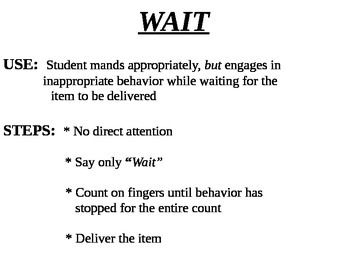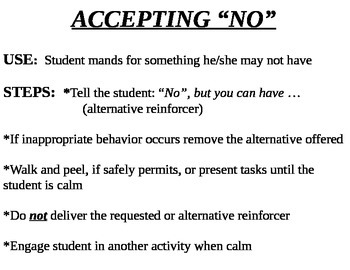4 Behavior Protocols Escape Distinction, Accepting NO, Waiting, and Count + Mand
Nick Knacks for the Knapsack
231 Followers
Grade Levels
PreK - 7th
Subjects
Resource Type
Formats Included
- PDF
Pages
4 pages
Nick Knacks for the Knapsack
231 Followers
Description
4 Behavior Protocols
This form shows proper protocols for the following behaviors:
1 - Student is engaging in inappropriate behavior to get something they
CAN HAVE (count and mand)
2 - Student engages in inappropriate behavior in response to a
demand. (escape distinction)
3 - Student mands appropriately, but engages in inappropriate
behavior while waiting for the item to be delivered. (waiting)
4 - Student mands for something he/she may not have. (accepting no)
See preview for better description.
Great for ABA
MAND - Mand is a term that B.F. Skinner used to describe a verbal operant in which the response is reinforced by a characteristic consequence and is therefore under the functional control of relevant conditions of deprivation or aversive stimulation. One cannot determine, based on form alone, whether a response is a mand; it is necessary to know the kinds of variables controlling a response in order to identify a verbal operant. A mand is sometimes said to "specify its reinforcement" although this is not always the case. Skinner introduced the mand as one of six primary verbal operants in his 1957 work, Verbal Behavior.
This form shows proper protocols for the following behaviors:
1 - Student is engaging in inappropriate behavior to get something they
CAN HAVE (count and mand)
2 - Student engages in inappropriate behavior in response to a
demand. (escape distinction)
3 - Student mands appropriately, but engages in inappropriate
behavior while waiting for the item to be delivered. (waiting)
4 - Student mands for something he/she may not have. (accepting no)
See preview for better description.
Great for ABA
MAND - Mand is a term that B.F. Skinner used to describe a verbal operant in which the response is reinforced by a characteristic consequence and is therefore under the functional control of relevant conditions of deprivation or aversive stimulation. One cannot determine, based on form alone, whether a response is a mand; it is necessary to know the kinds of variables controlling a response in order to identify a verbal operant. A mand is sometimes said to "specify its reinforcement" although this is not always the case. Skinner introduced the mand as one of six primary verbal operants in his 1957 work, Verbal Behavior.
Total Pages
4 pages
Answer Key
N/A
Teaching Duration
N/A
Report this resource to TPT
Reported resources will be reviewed by our team. Report this resource to let us know if this resource violates TPT’s content guidelines.





